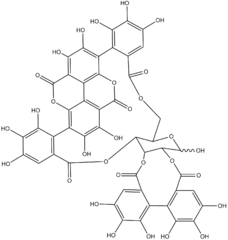Punicalagin facts for kids
Quick facts for kids Punicalagin |
|
|---|---|
 |
|
| Other names | 2,3-(S)-hexahydroxydiphenoyl-4,6-(S,S)-gallagyl-D-glucose α-punicalagin β-punicalagin |
| Identifiers | |
| CAS number | |
| PubChem | |
| SMILES | C1C(C(OC(=O)C2=CC(=C(C(=C2C3=C(C(=C4C5=C3C(=O)OC6=C(C(=C(C7=C(C(=C(C=C7C(=O)O1)O)O)O)C(=C56)C(=O)O4)O)O)O)O)O)O)O)C8C(OC(=O)C9=CC(=C(C(=C9C1=C(C(=C(C=C1C(=O)O8)O)O)O)O)O)O)C=O)O |
| Properties | |
| Molecular formula | C48H28O30 |
| Molar mass | 1084.71 g/mol |
| Except where noted otherwise, data are given for materials in their standard state (at 25 °C, 100 kPa) | |
Punicalagin is an ellagitannin, a type of phenolic compound. It is found in forms alpha and beta in pomegranates (Punica granatum), in Terminalia catappa and Terminalia myriocarpa, and in Combretum molle, the velvet bushwillow, a plant species found in South Africa. These three genera are all Myrtales and the last two are both Combretaceae.
Research
Punicalagins are water-soluble and hydrolyze into smaller phenolic compounds, such as ellagic acid. There were no toxic effects in rats on a 6% diet of punicalagins for 37 days. In laboratory research, punicalagins had carbonic anhydrase inhibitor activity.
See also
 In Spanish: Punicalagina para niños
In Spanish: Punicalagina para niños

All content from Kiddle encyclopedia articles (including the article images and facts) can be freely used under Attribution-ShareAlike license, unless stated otherwise. Cite this article:
Punicalagin Facts for Kids. Kiddle Encyclopedia.
